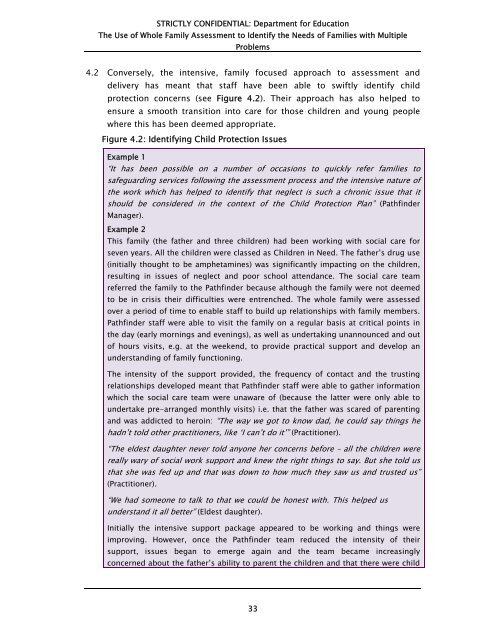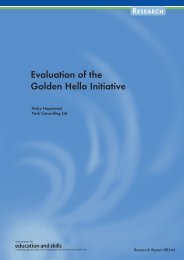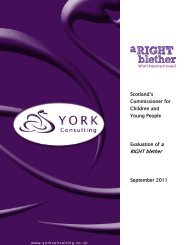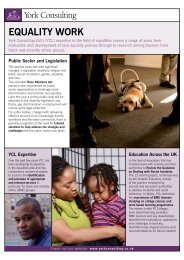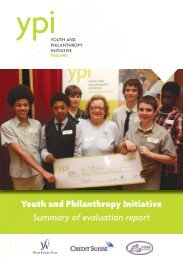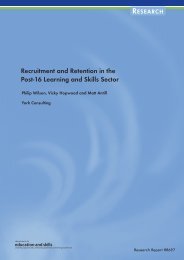The use of whole family assessment to identify the needs of families ...
The use of whole family assessment to identify the needs of families ...
The use of whole family assessment to identify the needs of families ...
Create successful ePaper yourself
Turn your PDF publications into a flip-book with our unique Google optimized e-Paper software.
STRICTLY CONFIDENTIAL: Department for Education<strong>The</strong> Use <strong>of</strong> Whole Family Assessment <strong>to</strong> Identify <strong>the</strong> Needs <strong>of</strong> Families with MultipleProblems4.2 Conversely, <strong>the</strong> intensive, <strong>family</strong> foc<strong>use</strong>d approach <strong>to</strong> <strong>assessment</strong> anddelivery has meant that staff have been able <strong>to</strong> swiftly <strong>identify</strong> childprotection concerns (see Figure 4.2). <strong>The</strong>ir approach has also helped <strong>to</strong>ensure a smooth transition in<strong>to</strong> care for those children and young peoplewhere this has been deemed appropriate.Figure 4.2: Identifying Child Protection IssuesExample 1“It has been possible on a number <strong>of</strong> occasions <strong>to</strong> quickly refer <strong>families</strong> <strong>to</strong>safeguarding services following <strong>the</strong> <strong>assessment</strong> process and <strong>the</strong> intensive nature <strong>of</strong><strong>the</strong> work which has helped <strong>to</strong> <strong>identify</strong> that neglect is such a chronic issue that itshould be considered in <strong>the</strong> context <strong>of</strong> <strong>the</strong> Child Protection Plan” (PathfinderManager).Example 2This <strong>family</strong> (<strong>the</strong> fa<strong>the</strong>r and three children) had been working with social care forseven years. All <strong>the</strong> children were classed as Children in Need. <strong>The</strong> fa<strong>the</strong>r’s drug <strong>use</strong>(initially thought <strong>to</strong> be amphetamines) was significantly impacting on <strong>the</strong> children,resulting in issues <strong>of</strong> neglect and poor school attendance. <strong>The</strong> social care teamreferred <strong>the</strong> <strong>family</strong> <strong>to</strong> <strong>the</strong> Pathfinder beca<strong>use</strong> although <strong>the</strong> <strong>family</strong> were not deemed<strong>to</strong> be in crisis <strong>the</strong>ir difficulties were entrenched. <strong>The</strong> <strong>whole</strong> <strong>family</strong> were assessedover a period <strong>of</strong> time <strong>to</strong> enable staff <strong>to</strong> build up relationships with <strong>family</strong> members.Pathfinder staff were able <strong>to</strong> visit <strong>the</strong> <strong>family</strong> on a regular basis at critical points in<strong>the</strong> day (early mornings and evenings), as well as undertaking unannounced and out<strong>of</strong> hours visits, e.g. at <strong>the</strong> weekend, <strong>to</strong> provide practical support and develop anunderstanding <strong>of</strong> <strong>family</strong> functioning.<strong>The</strong> intensity <strong>of</strong> <strong>the</strong> support provided, <strong>the</strong> frequency <strong>of</strong> contact and <strong>the</strong> trustingrelationships developed meant that Pathfinder staff were able <strong>to</strong> ga<strong>the</strong>r informationwhich <strong>the</strong> social care team were unaware <strong>of</strong> (beca<strong>use</strong> <strong>the</strong> latter were only able <strong>to</strong>undertake pre-arranged monthly visits) i.e. that <strong>the</strong> fa<strong>the</strong>r was scared <strong>of</strong> parentingand was addicted <strong>to</strong> heroin: “<strong>The</strong> way we got <strong>to</strong> know dad, he could say things hehadn’t <strong>to</strong>ld o<strong>the</strong>r practitioners, like ‘I can’t do it’” (Practitioner).“<strong>The</strong> eldest daughter never <strong>to</strong>ld anyone her concerns before – all <strong>the</strong> children werereally wary <strong>of</strong> social work support and knew <strong>the</strong> right things <strong>to</strong> say. But she <strong>to</strong>ld usthat she was fed up and that was down <strong>to</strong> how much <strong>the</strong>y saw us and trusted us”(Practitioner).“We had someone <strong>to</strong> talk <strong>to</strong> that we could be honest with. This helped usunderstand it all better” (Eldest daughter).Initially <strong>the</strong> intensive support package appeared <strong>to</strong> be working and things wereimproving. However, once <strong>the</strong> Pathfinder team reduced <strong>the</strong> intensity <strong>of</strong> <strong>the</strong>irsupport, issues began <strong>to</strong> emerge again and <strong>the</strong> team became increasinglyconcerned about <strong>the</strong> fa<strong>the</strong>r’s ability <strong>to</strong> parent <strong>the</strong> children and that <strong>the</strong>re were child33


